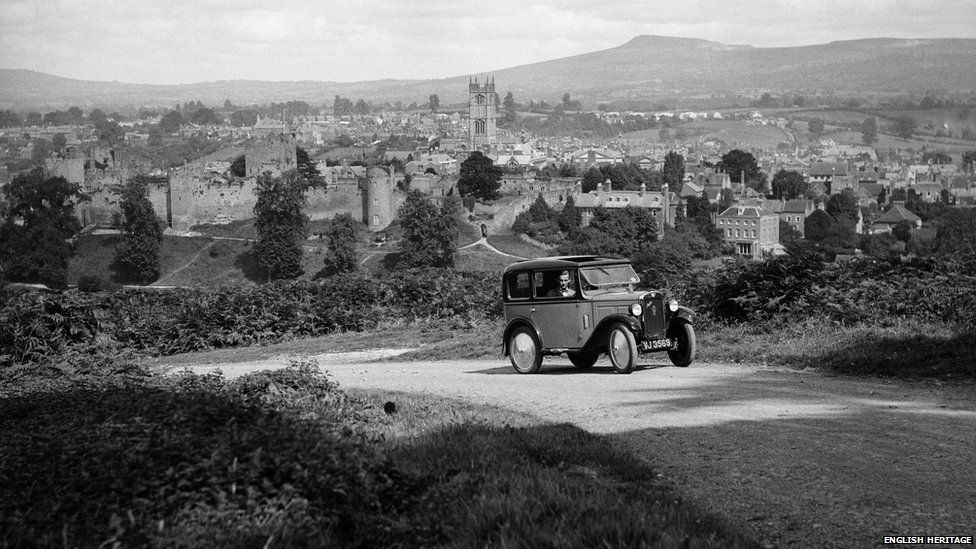In pictures: Landscape or carscape?
- Published

Jumping behind the wheel and enjoying the thrill of the open road has called many through the years and yet the automobile is responsible for far more than just the wide expanses of Tarmac that now criss-cross England, shaping both the architecture and landscape around us.
Image source, English Heritage
Firstly there are the showrooms that entice prospective buyers with cars of gleaming metal and polished chrome on show. This picture shows one of the earliest purpose-built car showrooms in London, dating from 1905-6 and situated on Long Acre. The British Motor Trading Corporation was a short-lived company controlling the productions of Bean, Swift and Vulcan vehicles.
Image source, English Heritage
By the 1960s, the windows of showrooms had become bigger, offering the passer-by a chance to view the cars on offer more easily, with slender bars ensuring their gaze is unbroken. This showroom rotunda in Alderley Edge in Cheshire was built for Total in 1962 with inclined glazing and a shelter above, both of which reduce reflections, and at one time the roof also protected petrol pumps.
Image source, English Heritage
The latest designs take their inspiration from the continent. This showroom in Gateshead was pre-fabricated in Germany with a tower that holds 31 cars, each of which can be retrieved for a customer within a minute.
Image source, English Heritage
Without the filling station our cars would go nowhere, and one of the earliest stations to open in London was this Anglo-American Oil Company one on the Euston Road in 1922. The kiosk and pumps are unmistakable, though the sweep of the route through is not something we see often today. This picture was taken by Bedford Lemere whose work is now held by English Heritage.
Image source, English Heritage
Today's petrol stations are, much like the cars on the road, seemingly all the same, yet that was not always the case. This Eliot-Noyes designed Mobil Pegasus canopies station on the A6 at Leicester is perhaps the last example of its kind, and seen here in Esso branding following their takeover of Mobil.
Image source, English Heritage
Many of the privately-run small stations now lie derelict or have been demolished. This is Bond's garage in Barkway, Hertfordshire, which when photographed in 2009 was virtually unchanged from when it was constructed in 1938.
Image source, English Heritage
Of course the motorist needs somewhere to keep his beloved automobile and for those not lucky enough to have their own space new services emerged, that of the parking garage offering long-term storage. This is the Wolseley Tool and Motor Car Company Garage (The New Niagara) in York Street, Westminster, as it was in 1913. A former ice rink, it garaged 60 cars and offered a wide range of facilities to chauffeurs, though they were forbidden to smoke.
Image source, English Heritage
Daimler's hire garage in London is seen here in a 1930s photograph by H Felton and was one of the first to be listed. Daimler was among the most successful upmarket car-hire outfits in London and offered an air service to France in the 1920s as well as taking over Harrods' car-hire business in 1930.
Image source, English Heritage
By the 1960s stylish modern car parks were incorporated into city centre shopping complexes such as Trinity Square in Gateshead - which featured in the film Get Carter in 1971. The cafe on the top floor never opened to the public.
Image source, English Heritage
Today's out-of-town shopping centres cover vast areas with car parks that dwarf the retail units, as seen here at Bluewater shopping centre beside the River Thames with the Queen Elizabeth Bridge in the distance.
Image source, English Heritage
As part of the original design of the motorway network, service stations were planned at regular intervals to help motorists on long journeys. The sites were selected by the Ministry of Transport but the individual designs were left to the private operators. Some, like Charnock Richard services on the M6, placed their restaurant space on the bridge so the motorist could enjoy a view of the speeding vehicles, part of the new motorway experience.
Image source, English Heritage
Away from the motorways, pubs and privately owned cafes offered drivers a break on the network of A roads, though chains such as Little Chef, which opened in 1958 and the Happy Eater, which followed in 1973, providing a regular menu with service based on the American waitress model.
Image source, English Heritage
In 1904 there were just over 30,000 cars licensed for use on the roads of Great Britain, today there are more than 24 million, so it is no surprise that much of the landscape around us is shaped, not for our needs, but that of our four-wheeled friend, the car. The pictures were taken from Carscapes, The Motor Car, Architecture and Landscape in England by Kathryn A Morrison and John Minnis, published by Yale University Press.
Related Internet Links
The BBC is not responsible for the content of external sites.